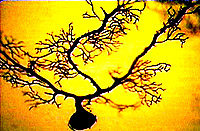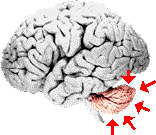Neuroscience For Kids
Eugene O'Neill - What Went Wrong?
April 22, 2000

The Man
Eugene O'Neill is perhaps the most well-known American playwright. He was awarded Pulitzer Prizes in 1920, 1922, 1928 and 1957 and a Nobel Prize for literature in 1936. Yet for all of his writing success, O'Neill led a life filled with tragedy and he was afflicted with a misdiagnosed neurological disorder that contributed to his death. Now, almost 47 years after O'Neill's death and with the permission of O'Neill's surviving grandchildren, the autopsy results of this amazing writer have been released. These results, published in The New England Journal of Medicine (NEJM, April 13, 2000), shed new light on O'Neill's health.
 Eugene Gladstone O'Neill was born in New York City on
October 16, 1888. He had a reputation for heavy alcohol drinking, and he
attempted suicide in 1912. In addition to surviving battles with malaria
and tuberculosis, O'Neill struggled with bouts of depression, some of
which required a stay in the hospital. Many biographers believe that
depression also affected O'Neill's mother, father, brother and two sons.
Two of O'Neill's sons, Eugene Jr. and Shane, committed suicide.
Eugene Gladstone O'Neill was born in New York City on
October 16, 1888. He had a reputation for heavy alcohol drinking, and he
attempted suicide in 1912. In addition to surviving battles with malaria
and tuberculosis, O'Neill struggled with bouts of depression, some of
which required a stay in the hospital. Many biographers believe that
depression also affected O'Neill's mother, father, brother and two sons.
Two of O'Neill's sons, Eugene Jr. and Shane, committed suicide.
Neurological Symptoms
 According to the new NEJM report, O'Neill noticed slight shaking
(tremor) of his hands when he was a freshman at Princeton University in
1906. These tremors became worse over the years and in 1941 he was
diagnosed with Parkinson's disease.
According to the new NEJM report, O'Neill noticed slight shaking
(tremor) of his hands when he was a freshman at Princeton University in
1906. These tremors became worse over the years and in 1941 he was
diagnosed with Parkinson's disease.
Other symptoms displayed by O'Neill:
- Difficulty writing: trembling hands made his writing difficult to read.
- Unsteady gait: he had difficulty walking.
- Problems with motor coordination: he had trouble using his arms to feed himself.
- Speech problems: it became difficult to understand what he was saying.
O'Neill tried various drugs to help with these problems, but none of them had a beneficial effect.
The Brain
 O'Neill's brain weighed 1.33 kg, well within the normal range. However, a
significant abnormality was found in his cerebellum. The cerebellum is
the part of the brain important for controlling posture, balance and motor
coordination. In O'Neill's brain, certain areas of the cerebellar cortex
had shrunk. In fact, over 90% of the "Purkinje cells" in the part of the
cerebellum called the "vermis" was lost. Purkinje cells (see photo to the
right) are neurons that send projections out of the cerebellar cortex to
deep cerebellar nuclei; from these areas, messages go to other areas of
the brain that influence movement. The number of another type of neuron
called the granule cell was also reduced in the vermis. No abnormalities
were found in the cerebral cortex or the substantia nigra. In cases of
Parkinson's disease, neurons in the substantia nigra degenerate.
O'Neill's brain weighed 1.33 kg, well within the normal range. However, a
significant abnormality was found in his cerebellum. The cerebellum is
the part of the brain important for controlling posture, balance and motor
coordination. In O'Neill's brain, certain areas of the cerebellar cortex
had shrunk. In fact, over 90% of the "Purkinje cells" in the part of the
cerebellum called the "vermis" was lost. Purkinje cells (see photo to the
right) are neurons that send projections out of the cerebellar cortex to
deep cerebellar nuclei; from these areas, messages go to other areas of
the brain that influence movement. The number of another type of neuron
called the granule cell was also reduced in the vermis. No abnormalities
were found in the cerebral cortex or the substantia nigra. In cases of
Parkinson's disease, neurons in the substantia nigra degenerate.
The Diagnosis
 The examination of O'Neill's brain clearly
shows that he did not have Parkinson's disease.
Parkinson's disease is characterized by severe degeneration of neurons in
the substantia nigra. This abnormality was not seen in
O'Neill's brain. Most likely, O'Neill suffered from a disorder called
"late-onset cerebellar cortical atrophy." The authors of
the NEJM paper argue that it was unlikely that this disorder was
caused by alcohol consumption because O'Neill had a decent diet and did
not abuse alcohol in the later years of his life. Rather, this disorder
may have been inherited.
The examination of O'Neill's brain clearly
shows that he did not have Parkinson's disease.
Parkinson's disease is characterized by severe degeneration of neurons in
the substantia nigra. This abnormality was not seen in
O'Neill's brain. Most likely, O'Neill suffered from a disorder called
"late-onset cerebellar cortical atrophy." The authors of
the NEJM paper argue that it was unlikely that this disorder was
caused by alcohol consumption because O'Neill had a decent diet and did
not abuse alcohol in the later years of his life. Rather, this disorder
may have been inherited.
References
- Price, B.H. and Richardson, E.P., The neurological illness of Eugene O'Neill - A clinicopathological report, The New England Journal of Medicine, April 13, 2000.
- Black, S.A., Eugene O'Neill. Beyond Mourning and Tragedy. New Haven: Yale University Press, 1999.
- Purkinje cell image courtesy of "The Slice of Life"
More information about Eugene O'Neill:
Copyright © 1996-2015, Eric H. Chudler All Rights Reserved.
